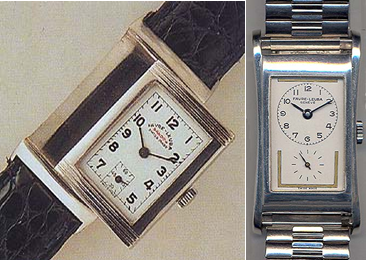By Bruce Shawkey
Favre-Leuba’s (FL) roots go all the way back to a rather storybook beginning of 1737, when Abraham Favre opened a small watchmakers workshop in Le Locle, thereby staking a claim to be one of the oldest watch brands in existence. Watch companies like to do this to distinguish themselves among the over 200 brands and sub-brands of watches on the market these days. FL really didn't begin to gain traction until the late 19th century. By this time, we are into the 5th generation of the Favre family. The then-patriarch of the clan, Fritz, married Adele-Fanny Leuba, and thus Favre-Leuba was formed, spreading the brand throughout Asia, especially India. A pocket watch from those early days is seen below left and is typical of watches of the era.
Some sources have lumped FL in that genre of brands little known and quickly forgotten, which is unfortunate, but understandable.
First, there is the name, which no one seems to agree how to pronounce. Depending on whether you're of Swiss or French persuasion, Favre can be pronounced FARV, (as in football quarterback Brett Favre), or FAV-ray. Then there's Leuba, which is equally confusing as to whether to emphasize the "e" or the "u." Current company execs pronounce it FAV-ray LOO-bah.
Then, there's the 22-year disappearance of the brand from the beginning of the 1990s to 2012. People, especially Americans have short memories and if something is gone for even a short time, we tend to forget about it.
Finally, FL has a reputation as a one-trick pony, namely the Bivouac, introduced in 1963, and its cousin the Bathy, introduced in 1968. To be sure, they were (and still are) pretty amazing watches, measuring air pressure by means of a sealed aneroid (without oxygen) drum housed inside the case atop the movement. For the record, though, FL made some pretty cool wristwatches,
starting in the '20s when wristwatches were beginning to supersede pocket watches. The company achieved sufficient reputation to begin expanding markets beyond India and Asia to Switzerland and the rest of Europe and introducing wristwatches. Under the direction of 6th generation Henri Favre-Leuba, some very neat pieces were produced, including a long rectangle bearing a striking resemblance to Gruen's Techniquadron, and another model, a dead ringer for Jaeger-LeCoultre's Reverso. Surviving examples are hard to come by, but a couple are shown at right. The company’s first commercially successful automatic movement was the Caliber 103. Introduced in 1956, the 11-1/2 ligne movement was built in-house and featured 21 jewels with a running reserve time of 43 hours. That same year, the company came out with the Caliber 104, basically a 103 with the addition of a date feature. The company also referred to that caliber as the Daymatic. They proudly announced those Calibers in a number of trade and consumer ads, a couple of which are shown below.

FL continued to make manual wind watches (below) with their own Calibers, and also offered complicated watches: Chronographs, triple dates, triple-date moonphases and even a triple-date moonphase chronograph (also below). The movements for these complicated watches were obtained from the usual ebauche sources (Valjoux, ETA, etc.)
In spite of all these innovations, the brand remained virtually unknown in this country until the '60s, and even then became a niche brand among watch enthusiasts, mountain climbers, and dive enthusiasts due to FL’s two signature innovations.

After the Bivouac came the “Bathy,” (also above) a watch worn below sea level. First came the "Bathy 50" in 1966 with a depth rating of 50 meters, followed by the “Bathy 160.“ Both Bivouac and Bathy are thick watches to accommodate the pressure disk. Both have become cult classics among watch collectors and collectors of diving memorabilia, and are a staple in FL’s current catalog.
The company also distinguished itself in 1963 with the introduction of the manual wind Caliber 251 (ad shown right) with twin mainspring barrels instead of one, and a sweep second hand (unusual for a watch a mere 3mm thick). The double barrels assured more uniform transmission of power to the drive train. This became the basis for the automatic Caliber 269 (aka Twinmatic/Duomatic), hailed by critics as an elegant design.
What followed for the next couple decades is a weird dichotomy. On the one hand, FL offered time-honored shapes and features true to its traditions (below).
On the other hand, FL promoted watches with shapes and gimmicks and very little innovation (also below) as Henry A. Favre’s children, Florian and Eric (now the 8th generation), struggled to keep the company afloat. It’s easy for us, with the benefit of hindsight, to say that this latest Favre generation abandoned traditions and gave in to the whims of fashion. But we must remember that Favre-Leuba had to take the necessary steps to stay in business. Images below provide a glimpse of what FL was doing during these years.
Traditional designs:
More trendy designs:


As mentioned at the beginning of this article, darkness descends on FL between 1990 and about 2012. The FL family seems to have run out of innovation, passion, or both. I find no evidence of advertising during this time nor any watches from this time period being sold or auctioned, not counting items offered where the seller is error.
Then, in 2012, a rebirth. FL is acquired by the Tata Group. This multinational conglomerate headquartered in Mumbai, is India's largest conglomerate. Founded in 1868, it has operations in 100 countries across six continents, selling everything from coffee to military vehicles. Favre-Leuba watches are still made in Switzerland, but the purse strings are controlled from India. The watches have returned to a more consistent look, reflective of the traditional Favre-Leuba. Samples from its website (https://favre-leuba.com/) are shown below.









